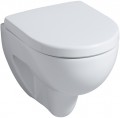Bowl shape
The overall shape of the toilet bowl.
The choice of this parameter largely depends on the aesthetic preferences of the user and the overall design of the bathroom; however, the shape of the bowl is quite practical. So, in our time, the most common is
semicircular models, where the rear edge of the bowl is made straight, and the rest - rounded (oval, egg-like, etc.). This shape not only looks good - it is convenient to sit on, and the absence of angles (at least in front of the bowl) facilitates cleaning and reduces the risk of hitting the toilet with your foot. In addition, material on such a bowl requires less than a rectangular product of similar dimensions - as a result, semi-circular toilet bowls are relatively inexpensive and light.
The rectangular shape, in turn, gives a larger support area, which is important for users of large physique. However, toilet bowls
classical rectangular shape are rare (due to the high cost of production, as well as for some other reasons). Much more common are variations on this topic - the bowls
, with bevelled (rounded) corners, as well as
, with the front end shaped arc.
Weight
The total weight of the product; for compact-toilet (cf. «Type»), as a rule, is specified for standard equipment - together with «native» tank (empty).
When choosing floor models on this indicator you can not pay much attention, but for a hanging toilet bowl (see. «Installation») weight is quite principial: because the installation (or other attachment) should normally withstand both the design and the user sitting on it.
Dimensions (HxWxD)
General dimensions of the toilet bowl in height, width and depth (by depth is meant the distance from the front edge to the rear edge).
These indicators allow you to determine how much space is required to install the product, and also affect some practical points. In this case, width and depth are of key importance. Specific figures and nuances for these dimensions are as follows:
- Width:
up to 35 cm in the narrowest models,
40 cm or more in the widest, intermediate options -
36 - 37 cm and
38 - 39 cm. A large width is desirable if people of large build will use the toilet. However, it should be borne in mind that this dimensions is indicated by the widest part of the structure, and this is not necessarily a bowl - we can talk about a tank.
- Depth:
up to 50 cm - is considered small, in the largest products -
more than 65 cm ; intermediate options include
51 - 55 cm,
56 - 60 cm and
61 - 65 cm. Here the choice depends on the height and physique of the user: tall people and people with long legs will be most comfortable with toilets with great depth.
Height is worth mentioning. In models without a tank, it corresponds to the height of the bowl
..., see more about this indicator above. In compact toilets (see "Type"), the height with the tank is usually indicated, it depends on how much vertical space is required for installation. Here, an indicator of 75 cm or less is considered small, 76 - 80 cm is average, 81 - 85 cm is above average, and for the highest products, more than 85 cm of free space above the floor will be required.Country of origin
The country of origin of the brand under which the toilet is marketed. Nowadays, on sale you can mainly find products from such countries (in alphabetical order):
Belgium,
Germany,
India,
Spain,
Italy,
Poland,
Turkey,
France,
Czech Republic,
Switzerland,
Sweden,
Japan.
There are many stereotypes related to how the origin of goods from a particular country affects their quality. However, in general, these stereotypes are unfounded. Firstly, this paragraph does not indicate the actual place of manufacture of the toilet bowl, but the "homeland" of the trademark (or the location of the manufacturer's headquarters); production facilities may be located in another country. Secondly, the actual quality of the product depends not so much on geography, but on the organization of processes within a particular company. So when choosing, it is best to focus not so much on the "nationality" of the toilet, but on the overall reputation of a particular brand. And paying attention to the country of origin makes sense if you fundamentally want (or do not want) to support a manufacturer from a
...certain state.
